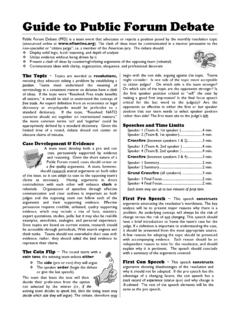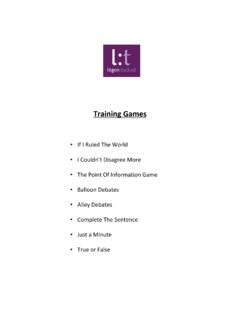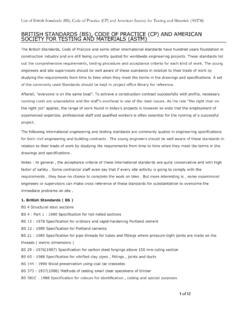Transcription of British Parliamentary Debating - Debate Central
1 British ParliamentaryDebating2 Contents1. Introduction2. The format, or, Rules of the game 3. The positions and roles4. Motions and definitions5. Style or substance?6. Judging7. What next?31. IntroductionThere is a reason why this guide is not called How to win in BritishParliamentary Debating , or even How to avoid losing in BPD becausethere is not, will never be, and cannot be a foolproof way of winning, oreven avoiding last place, in a Debate . If there were, the book would havebeen written, we would all have read it and Debating as a competitiveactivity would cease to exist!
2 That being said, the aim of this guide is to help you prepare as muchas possible for Debate competitions conducted in the British Parliamentarystyle. We will look at the format of debates, and what are termed thestanding orders, the speakers positions in the Debate and the role they arerequired to fulfil, motions and how (and when) to define them, style andsubstance (also called matter and manner ), the vagaries of judging andhow to cope with them, and finally, where to go, and what to do from the end of the pack, you will hopefully feel confident that youknow what you are doing, and to a certain extent, how you are going to doit.
3 Remember, you can have all the advice, encouragement and coaching inthe world, but when you go into a Debate and you stand up to speak, it s alldown to The format, or, Rules of the gameThere are many different styles of Debating around the world USParliamentary, Australs, even the Dutch do it differently but the one thatconcerns us here is British Parliamentary Debating , or BP, for short. This isthe standard form used at university level and differs radically from theschools style to which some young debaters are used. BP debates consistof four teams of two speakers each, broken down as follows:!
4 1st Proposition (sometimes called 1st Government)! 1st Opposition! 2nd Proposition (or Government)! 2nd OppositionThe speakers speak in rotation, beginning with the first team member of1st Proposition ( the Prime Minister ). He or she is followed by the openingspeaker for 1st Opposition ( Leader of the Opposition ), who in turn isfollowed 1st Propositions second speaker ( the Deputy Prime Minister )and so on down the table until all speeches have been completed. The tablebelow explains MinisterLeader of theOpposition2ndSpeaker3rdSpeakerDeputy Prime MinisterDeputy Leader of theOpposition4thSpeaker5thSpeakerMember forGovernmentMember for theOpposition6thSpeaker7thSpeakerGovernm ent WhipOpposition Whip8thSpeaker5 When all eight speeches have been delivered, the Debate is considered atan end, and the judging process begins (see Judging , ) So far, sostraightforward.
5 But there are certain conventions and expectations in BPdebates and this is what we mean when talking about the rules of thegame .First, BP Debating aims to recreate to a degree the style of debatingpractised in Parliament and in august institutions such as the Oxford andCambridge Unions. It is therefore essential that Parliamentary language isused at all times. Thus, debaters are addressed as Sir or Madam , thechair of the Debate is often referred to as Mr Speaker , and debaters willoften make reference to members of the House . While this may seemexcessively formal, there is good reason.
6 A Debate is not an argument inthe sense that most of us understand that word it is not about shoutingmore loudly or more forcefully than your opponent (see Style orsubstance? ) or insulting them. They may smell a bit, look like abulldog eating a wasp, or have the most ridiculous hair since Einstein, butpointing out will not win you the the contrary, if you are rude, you will be warned by the Chair, andyou may lose points, and subsequently, the Debate if you language is what is called for, and what the judges will expect tohear. It should not need to be stressed that vulgar language and swearingare never acceptable, but unfortunately, some people still forget.
7 Debatingis about making arguments in a controlled, adult fashion and any swearingis usually severely , we come to points of information (POIs). These are anintegral part of BP Debating , and one of the ways in which BP differs from6styles such as Australs. Speeches in BP tend to be of either five or sevenminutes (depending on the competition you will generally be told whichbefore the tournament begins), and the first and last minutes of eachspeech are protected . This means that no speaker from the opposingteams may interrupt the person making their speech during this time.
8 In theinterim three (or five) minutes, however, POIs are positively will look at POIs in more detail later (see Positions and roles , ), butfor now it is enough to say that there are ways of making POIs which areacceptable, and some which are clearly simplest, and possibly the best, way of offering a POI (we willlook at how to make the point later) is to stand and say On a point ofinformation in a loud, clear voice. On that point , or more simply, Point,Sir/Madam are also acceptable. Whichever you choose, you must wait forthe speaker to accept or decline your point.
9 If you are accepted, make yourpoint quickly (about 30 seconds or so). If you are declined, take your seatimmediately. What is not acceptable is to stand and simply start speakingwithout being invited to take the floor, or to offer the point in such a waythat the point is made, On the fact that violent crime is on the rise andyour model only makes this (It is extremely difficult to give anexample in the abstract, but hopefully, you get the idea.) The last point regarding format and rules is that when a speaker hasthe floor, that is the only person to whom the judges want to listen andshould be listening.
10 You may want to discuss issues as they arise withyour partner, for example when to offer a POI and what to say, but youshould be able to do this in such a way that the judges are not distracted. Ifyou cannot speak quietly enough (and judges will not be shy about lettingyou know!), then pass small notes to each other. The House is a respectful7one, and all members, whether speaking or not, are expected to behave in acorrect and fitting Positions and rolesThis section will be broken down by speaker, outlining what thespeaker s position in a Debate means, and what is required for rolefulfilment.









